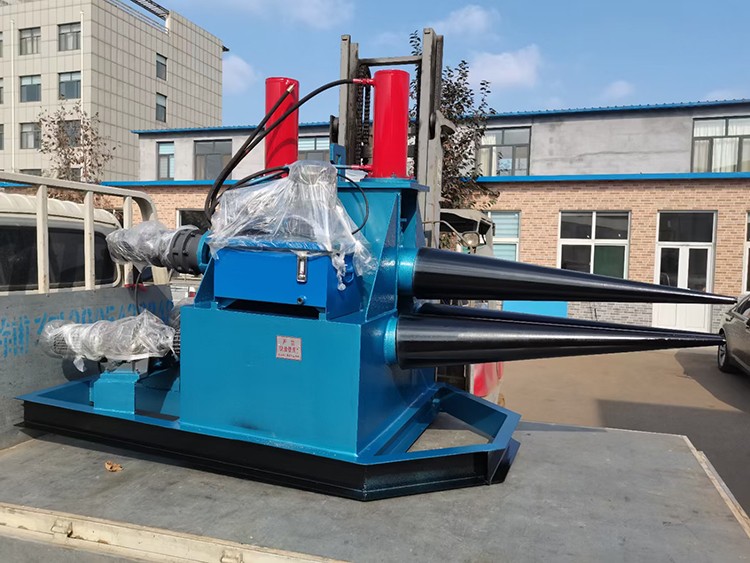

We are a professional manufacturer of cone rolling machine with over 10 years of experience in the industry. Here, we would like to introduce the material selection and service life extension strategies for cone crusher rollers:
Cone rolling machines are important equipment in metal processing, with their rollers directly participating in material forming and subjected to high pressure, friction, and cyclic loads. The selection of roller materials and maintenance strategies directly affect the service life and processing quality of the equipment. This article will explain the principles for selecting roller materials and methods for extending their service life.
1. Selection of roller material
The material of the roller must be selected based on a comprehensive consideration of wear resistance, fatigue resistance, impact resistance, and cost-effectiveness. Common roller materials include alloy steel, tool steel, cast iron, and surface-hardened materials. The appropriate material should be selected based on the specific operating conditions.
(1)Alloy steel (such as 42CrMo, GCr15)
Alloy steel has high strength and toughness, making it suitable for medium to high load roll cone operations. Its hardness and wear resistance can be further improved through tempering heat treatment, making it suitable for long-term continuous production. However, alloy steel is relatively expensive, so it should be selected based on production requirements.
(2)Tool steel (such as Cr12MoV, SKD11)
Tool steel has high hardness and good wear resistance, making it suitable for processing high-precision or high-hardness materials. Its disadvantage is that it is relatively brittle and may crack under impact loads, so it is more suitable for stable working conditions.
(3)Cast iron (such as high-chromium cast iron, ductile cast iron)
Cast iron is relatively inexpensive and has good shock absorption and wear resistance properties, making it suitable for low-speed, medium-to-low load cone rolling machine. High-chromium cast iron is particularly suitable for applications with high wear resistance requirements, but it has poor toughness and should be avoided in situations involving overload impacts.
(4)Surface hardening treatment (such as quenching, carburizing, and spraying hard alloy)
For ordinary carbon steel rollers, surface hardening treatment can be used to improve their wear resistance. For example, high-frequency quenching can enhance the hardness of the roller surface, while thermal spraying of hard alloys such as tungsten carbide can significantly extend the service life.
(5)When selecting materials, it is necessary to consider the processing materials (such as stainless steel, carbon steel, and aluminum alloy), production rhythm (continuous or intermittent operation), and cost budget to ensure that the rollers are both economically feasible and meet performance requirements.
2. Strategies for extending roller life
Roller wear and fatigue are the main factors affecting roller life. Roller life can be effectively extended by optimizing usage and maintenance methods.
(1)Reasonably adjust process parameters
Avoid excessive reduction or feed rates to reduce stress concentration on the roller surface.
Control processing temperature to prevent material softening or thermal fatigue cracks caused by overheating.
(2)Regular lubrication and cleaning
Use appropriate lubricants (such as high-viscosity industrial lubricating oil or graphite lubricant) to reduce friction between the rollers and the sheet metal.
Promptly remove metal debris and oxide scale to prevent them from scratching the roller surface or accelerating wear.
(3)Regular inspection and maintenance
Regularly measure the roundness and surface roughness of the rollers. If minor wear is detected, perform grinding to prevent defects from worsening.
Check the fit of bearings and transmission components to ensure smooth roller operation and reduce damage caused by excessive vibration.
(4)Avoid overloading
Never exceed the rated capacity of the equipment to prevent plastic deformation or fracture of the rollers due to overload.
When processing high-strength materials, use multiple progressive forming passes rather than a single large deformation process.
(5)Alternate use of spare rollers
For equipment that undergoes continuous high-load production, it is recommended to equip multiple sets of rollers for alternate use, so that the force is evenly distributed among the rollers and to prevent premature fatigue of a single set of rollers.
The selection of roller material should be based on processing requirements, balancing wear resistance, toughness, and cost. In terms of maintenance, reasonable process adjustments, regular lubrication, inspections, and rotation of use can effectively extend the service life of rollers. Scientific material selection and management not only reduce replacement frequency but also improve the stability of roll forming and product quality. Companies can develop suitable roller maintenance plans based on their production characteristics to achieve long-term efficient operation.
If you are interested in cone rolling machines, please contact us.

 Address:Room 1202, Detaitang Building, No. 118 Huaguang Road, Zhangdian District, Zibo, Shandong
Address:Room 1202, Detaitang Building, No. 118 Huaguang Road, Zhangdian District, Zibo, Shandong WhatsApp:+8615653328535
WhatsApp:+8615653328535 Wechat: +8615965331535
Wechat: +8615965331535  E-mail:zs@sdsmachinery.com
E-mail:zs@sdsmachinery.com